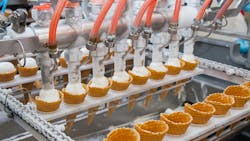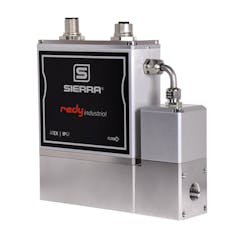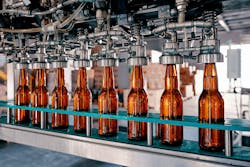Why accurate mass flow measurement and control are essential in food and beverage processing
When it comes to the various process manufacturing industries, thermal mass flow meters and controllers are used to measure direct mass flow. This method significantly impacts process efficiency, revenue and competitiveness. Leading the way for these continuous process improvements is the food and beverage industry.
Food and beverage processers are under continual pressure to provide naturally sourced healthy foods and beverages in an abundant variety, reduce waste, offer longer shelf life and adhere to FDA industry regulations in order to meet consumer demands and gain that hard-won sale1. Today's food and beverage landscape means using expensive natural ingredients, a trend toward on-demand manufacturing and varying process runs. Accurately measuring and controlling gas mass flow is essential for food and beverage processors to create a great-tasting quality product while improving their process and gaining a competitive advantage.
Why mass flow control improves the quality of food and beverages
In most gas flow applications, the critical variable is mass, not volume. Mass flow depends on the number of molecules in the flow — not the volume occupied by these molecules. This holds true for a wide range of applications in food and beverage processing, including ice cream aeration, food packaging, aerating beverages and precision fermentation, just to name a few. Mass flow measurement is the most accurate and meaningful method of measuring these gases and has the most significant effect on efficiency.
Why? Because mass flow is what goes in and out of any kind of biological reaction; the molecules themselves, not the volume of the molecules. Common process gases like air, argon, carbon dioxide (CO2), N2 and oxygen follow the “Ideal Gas Law.” While not all gases are “ideal,” these common gases work on the principle that when temperature or pressure changes in an application, the density changes for a fixed volume of gas. Thermal mass flow controllers and meters offer food and beverage processors direct gas mass flow measurement without pressure or temperature compensation using secondary inputs and a flow computer.2
Volumetric flow, on the other hand, is less reliable than mass flow to account for absolute measurements because changes in temperature and pressure (T&P) affect the gas density and thus reduce the accuracy of the flow measurement. Volumetric flow measurement also requires extra temperature and pressure compensation to “infer” true gas mass flow rate, which derates the accuracy and adds expense in extra equipment. Direct mass flow measurement through a mass flow controller is important because it gives food and beverage processors increased accuracy, application flexibility, superior product quality and, ultimately, more profit to the bottom line.3
Aeration — ice cream
From wine to chocolate, to ice cream and more, aeration is used in various food and beverage production processes to improve quality, create lighter textures, increase shelf life and increase profit. Air is an important natural ingredient in ice cream.4 Aeration is the process of injecting air bubbles repeatability into a product during processing. Repeatability and precise control of the air bubble size during food processing is a key aspect of aeration. A mass flow controller — with a wide flow range and high accuracy — gives food processors precise bubble size control during processing by controlling gas flows.
In ice cream aeration, manufacturers inject air into their products to give them a creamy and light texture. Aerating ice cream also ensures that the ice cream is less cold to the palate. High-quality ice cream contains natural ingredients and more cream than air.
Cost-conscious manufacturers often opt to use more air and less cream. Ice cream consists of about 50% air and 50% milk-cream mixture. Federal regulations limit air content, known as overrun, to 50% and manufacturers exceeding this level can be fined or shut down. Per the International Dairy Foods Association, “Overrun refers to the amount of aeration the ice cream undergoes during its manufacture that keeps the mixture from becoming an inedible frozen mass. Overrun is governed by federal standards in that the finished product must not weigh less than 4.5 pounds per gallon.”5 To avoid these problems manufacturers of ice cream have incorporated mass flow controllers in their equipment to control the air-to-cream ratio.
Mass flow controllers accurately measure and control the mass of air injected into the mixture, freeing operators from the lengthy and potentially inaccurate calculations required when using volumetric meters and manual valves.6
Mass flow control provides precise CO2 injection for brewery applications
Precise mass flow control of CO2 is a critical part of creating high-quality beers and other beverages during the beverage carbonation production process. It is pivotal that beverage processors have the ability to control the exact quantity of CO2 injected into their beverages during the bottling process.
Mass flow controllers are used to regulate and control the amount of CO2 injected into the bottles during filling and capping to assure uniformity of the product.
Too much CO2 in the beverage will lead to an overly carbonated beverage and could possibly break bottles causing safety issues and loss of product. Too little CO2 may cause the beverage to be “flat.” The batch would need to be tossed in either situation, affecting productivity and costs.
Many companies use volumetric flow and differential pressure devices for gas flow control for their CO2 injection process. However, volumetric flow devices are not suitable for this application given their sensitivity to heat and pressure fluctuations. Direct mass flow devices have successfully overcome these limitations and exhibit exceptional accuracy by accurately counting and controlling each gas molecule flowing through the instrument to achieve unmatched precision.
An industrial flow controller meets key requirements of the brewery/beverage industry with its precision accuracy, NEMA 6 & IP67 ratings, remote monitoring capability and rugged washdown protection. Because a direct mass flow controller is unaffected by upstream gas temperature and pressure fluctuations and provides smooth, stable, accurate and repeatable CO2 gas mass flow control, industrial flow controllers have become an industry standard for this application manufacturers can rely on.7
Food packaging
To package food, manufacturers use oxygen, nitrogen, carbon dioxide and other gases to increase the shelf life of perishable products. Injecting the proper amount of gas into food packages displaces the air and is especially important for products that have a limited shelf life and products food processors must refrigerate or ship long distances.
For example, in meat packaging, mass flow control of a mixture of CO2 and oxygen slows down the growth of aerobic organisms and helps prevent oxidation to reduce cylinder gas wastes and improves the throughput and performance of packaging equipment.8 Accurate and consistent gas mixing is critical in this application. Direct mass flow control of this gas mixture provides pure, repeatable results.
Fermenters — precision fermentation
Sterilization plays an important first step process with bioreactors. Having an operation that is cost-effective is mandatory. Heat alone is common practice, with some companies using hydrogen peroxide, and some now switching to ethylene oxide due to the harsh environment hydrogen peroxide can create. There are many gases used to control reactions and control growth in a wide variety of applications where fermenters are used.9
Bioreactors require precision mass flow control of the gases used to feed the biomass and to ensure proper mixing and distribution. This ensures healthy fermentation. Precision fermentation is an offshoot of this process. It encompasses two processes: fermentation and precision biology. A more advanced kind of metabolic fermentation, precision fermentation, is the process of genetically engineering microflora (such as yeast or bacteria) to make proteins or fats. This process provides a way for food engineers to produce an array of animal-free ingredients with the taste and functionality of dairy, eggs, collagen, gelatin and more.10
Benefits of mass flow technology
For food and beverage processors, proper flow measurement and control can bring considerable confidence in their processes. Mass flow measurement and control of gas flows provide them with the flow data they need to optimize their process, meet regulations, utilize expensive ingredients more effectively, reduce waste and create consistent high-quality products.
Jeff Gulla is the Sales Manager-Scientific MEMS Product Line at Sierra Instruments.
Maryadine Washington is the Marketing Communications Manager at Sierra Instruments.
REFERENCES
- Administration, U. F. (2020). Current Good Manufacturing Practices (CGMPs) for Food and Dietary Supplements. FDA.
- Instruments, S. (2017, 4 10). New Sierra Instruments’ Infographic Explains Advantage of Thermal. Retrieved from Sierra Instruments: www.sierrainstruments.com/userfiles/file/pressrelease
- The Importance of Aerating. (n.d.). Retrieved from Callebaut: www.callebaut.com/en-GB/ice-cream-chocolate/making-ice-cream/aerating
- NASA. (2021, 5 7). Gas Density. Retrieved from Glenn Research Center: www.grc.nasa.gov/WWW/BGH/fluden.html
- International Dairy Foods Association. (n.d.). Retrieved from Ice Cream Labeling: www.idfa.org/news-views/media-kits/ice-cream/ice-cream-labeling
- Instruments, S. (2000, 4) Application Guide to Low-Flow Gas Mass Measurement and Control.
- Instruments, S. (2019, 8) Brewery/Beverage Processes Application Tech Note www.sierrainstruments.com/userfiles/file/beverage-tech-note.pdf?utm_source=library&utm_campaign=tech_note&utm_medium=beverage-manufacturing-co2-injection
- Armson, M. (2013, 4 1). Scientist Live. Retrieved from Gas mixtures help preserve the quality of packaged meats: www.scientistlive.com/content/gas-mixtures-help-preserve-quality-packaged-meats
- Biology Discussion. (n.d.). Retrieved from Fermenters: History, Functions and Construction: www.biologydiscussion.com/industrial-microbiology-2/fermenters-history-functions-and-construction/66002
- RethinkX, disruptive technology think tank. (2020, 2 26). Retrieved from Precision Fermentation: What exactly is it?: https://rethinkx.medium.com/precision-fermentation-what-exactly-is-it-7004eeaa798e
Ideal flow technology for food and beverage applications offers:
- Reliable and repeatable gas flow control of gases.
- High Accuracy: up to ± 0.3% of full scale + ±0.5% of reading ± 1.0% of full scale (standard accuracy).
- IP67/NEMA 6 Rating, ATEX Certification (Category 3/Zone 2 & 22) standard.
- FDA-certified elastomers.
- Multigas option — One meter or controller can be used for different gases or gas mixtures.
- 316 stainless steel construction.
- Digital communications.
- Wide variety of field adjustable parameters.
- Small footprint, compact sizes to measure and control flow rates.


